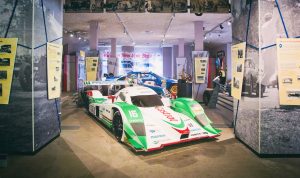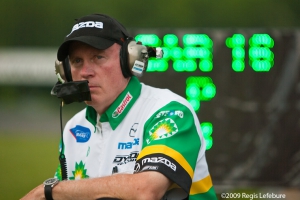Advanced Engine Research designed, developed and serviced the 2.0 liter, four-cylinder turbo engine that powered the Dyson Racing American Le Mans Series P1 entries. AER-built turbo-charged engines have powered Dyson’s LMP cars for ten of the past twelve seasons. Dyson Racing introduced an updated version of the AER four-cylinder in April of this year. The P90 features gasoline direct injection, a first for the two-liter engine and is based on a system researched for a Formula One team. Andrew Saunders, Engineering Manager of AER, gives us an inside look.
What are the benefits of the direct injection engine?
There are several. There is the accuracy of the delivery of the fuel within the cylinder and the pressure with which you can deliver the fuel. In our case, it is in excess of 250 bar. (3625 psi) With air restricted turbo charged engines, you get significant benefits from running GDI rather than port injection. There are also drivability advantages with a direct injection engine. When you perform torque reduction by cutting fuel, that torque reduction is instantaneous because the injector is within the cylinder – it is the equivalent of cutting the spark to the engine, whereas with our port injection engines, if you cut the fuel, it takes a few engine cycles to dry out any wall wetting or pooling in the port and inversely, when you turn the injector back on, it takes a number of cycles to get it wet again, whereas, with the GDI, it is immediate. So this helps all the drivability events you need on track including traction control, and gear cuts. In short, all torque reduction strategies work extremely well with GDI. Overall, the P90 delivers more horsepower, torque, fuel economy and better drivability and puts you on a more level playing field with normally aspirated engines.
So both better gas mileage and power?
Yes. You have to work hard to get the horsepower, as it does not come free. When you first fit the system, you typically have less power than when you started. But you work hard on the combustion chamber shape, the fuel pressure, and the nozzle angles of the injectors. A lot of CFD (computational fluid dynamics) and simulation work is done on these areas followed by testing on the dyno. So in the end, we have found more power and economy using the GDI system than with the port system.
When did development start?
It goes back a while now. AER was contracted by a Formula One company to develop a 1.6 liter four-cylinder GDI engine, and AER successfully produced that engine. It was a four-cylinder 1,600 cc dyno engine to allow for further development on their concept. The engine revved to 12,000 rpm could easily achieve 800 horsepower. It was a tool for a Formula One team engine supplier to take on and turn into a test bed for their further development. In the end, the rules changed and Formula One went to a V6 1,600 cc engine for the 2014 season. But it was a very successful and valid project for us and we learned a lot. That technology has been taken forward into our current LMP1 engine and it is also going into our new 2014 rules LMP1 engine which we are working very hard on.
When did Dyson first run the engine?
Our first track test was immediately after Sebring in March of this year. We had some issues and we went away and looked at those. We had planned on racing the engine at Long Beach. We fitted the engine and went out for the first practice session and the drivability and performance were exceptional. That one hour around Long Beach did highlight there were still some installation issues with the fueling system. It is a surprisingly difficult thing to do – to make the GDI injectors and their sealing mechanisms survive in the incredibly harsh environment of a two-liter turbocharged racing engine. For example, you have vibration issues that you would not have on a road car GDI installation. So for AER there was a period of time spent taking our dyno system which was perfect in terms of performance and making it work as a race car system with all the issues you actually face in a racing environment and submitting the installation to all the conditions you would not see in a steady state situation. It took us a couple of events to get that straightened out, but the system is now trouble free and has been running fault-free since Lime Rock. It is now reliable and robust in the car, so we have moved back to continuing to push the development side of it now.
I read a story that said that at the McLaren F1 team, five to ten percent of the car is new every race. How much changes race to race for an AER engine?
It depends on where you are on its evolution. In sports car racing with lower budgets those kind of percentage are probably true near the beginning of an engine’s life. You tend to push very hard to get your engine out and tested and in the car, but you probably have only 85 or 90 percent of the engine you wanted. And then the developments and improvements will continue in the engine’s early life and gradually trail off as there is not the funding in sports car racing for continuous aggressive development like there is in Formula One. We quietly work away at development items within budget and address any reliability issues that crop up. So I would say that towards the end of the first season, the engine is more stable but there is always improvement going on. For example, at COTA, we replaced a cast component on the water system. It was not unreliable, but had to be replaced on a regular basis. It was a cast part and we replaced it with a stronger part machined from solid billet. That is an example of ongoing updates, in this instance, based on reliability. It is not going to bring any performance advantages or weight reduction, but the chance of it cracking and leaking during a race event are now much reduced.
How many pages of notes do you take back to the office with you after a race?
We take back lots of notes, but more than that, we take home a huge amount of data – hundreds of megabytes of data which we analyze back at the office. We keep a very accurate data base of mileaged parts: when those parts are changed, if there are any problems with those parts, and if so, at what duty point did it occur. We write a race report and a daily run sheet of notes and that along with all the data goes back to AER after each event. And early in the following week, we will sit down and go through any issues and decide what is the best action to take regarding those items.


